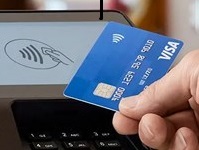
When an essential trip to the store is necessary, consumers want a touch-free shopping experience. Actually, they need a touch-free shopping experience, specifically at the payment terminal. Contactless cards can provide this with their tap and go functionality.
As consumers look for new ways to conduct transactions without touching common surfaces, interest in contactless payments is increasing. While contactless payments were being adopted in the U.S. prior to the COVID-19 pandemic, the arrival of this technology couldn’t have come at a better time.
Before COVID-19, some consumers in the U.S. were making the switch to contactless cards. Many merchants were also making changes by replacing traditional card terminals with contactless-enabled card readers. But adoption now could be accelerated in response to COVID-19 as more members demand this payment ability. In other countries, including Canada, England, and Australia, stores already have required consumers use contactless cards as the default payment method.
For consumers who become accustomed to using contactless cards, it is a habit that likely won’t be broken following the pandemic. Implementing and promoting contactless cards now helps members and merchants by reducing touchpoints. It also helps your card be the top pick in your members’ wallets.
The Tech Behind Contactless Cards
Contactless cards combine the security benefits of the EMV chip with the quick convenience of a traditional mag stripe transaction. Thanks to an antenna and a more powerful EMV chip embedded in the card, contactless cards eliminate dipping, swiping, and waiting. They’re like the smartphone of payment cards. At enabled terminals, the user simply holds the card within an inch of the POS terminal. If the terminal is not enabled, the card still could be dipped or swiped.
Member Experience: Top Priority
Contactless cards users report that they prefer this payment method once adopted. In addition to the touchless capabilities, transactions are faster and easier. There’s no chance of a card being left behind in the POS terminal and no annoying “remove card” sound effects. In the event a terminal is not enabled for touchless payments, contactless cards will still work because all possible card functions are built in (insert, tap, swipe, or key-entry). This flexibility also helps drive top-of-wallet status.
Implementing Contactless Cards
Visa and Mastercard each have their own requirements and recommendations for implementation. As issuers, credit unions will have to implement changes for instant issue, as these cards require additional keys and coding during setup. Credit unions also will need new plastics to accommodate the shift.
Educating staff and members alike will be essential. Similar to the “chip and dip” member education campaign, credit unions will need to explain to their members how to complete a contactless transaction, provide examples of where contactless cards are accepted, and emphasize the increased security and convenience of contactless cards. Including information like this in pre-printed inserts and newsletters, and on signage and monitors at the branch, are a few ways to spread the word on how to use contactless cards.
Planning Ahead
The queue to implement contactless cards is filling quickly. Contact us as soon as possible to hold your spot! To get started, please contact your Account Relationship Manager, or email ARM@synergentcorp.com.
New to Synergent? Please contact Fred Barber, Account Executive, to learn more about this and other services we offer to help credit unions thrive.

